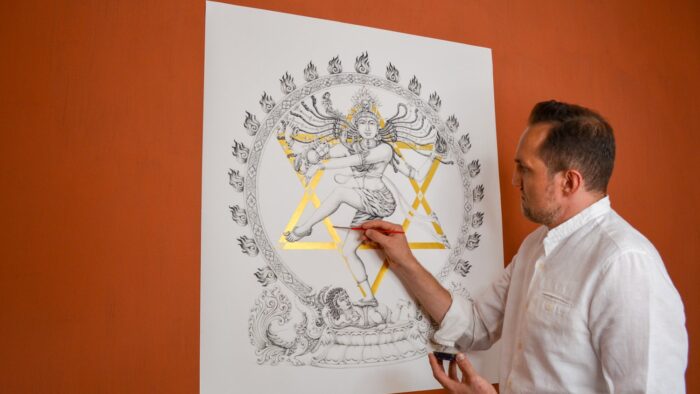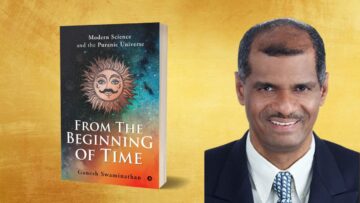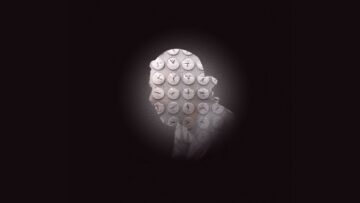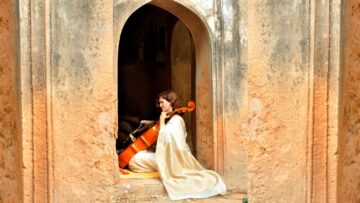Gentle brush strokes leave a ring of gold around Hanuman. They fall lightly on the circular path, lending a familiar lustre to the dip in gold. The gold surrounding the deity appears to momentarily reflect some of his own brilliance – before they get soaked by paper towards a permanent impression. These brush strokes resemble each day in the journey of artist Drdha Vrata Gorrick and his life dedicated to shilpashastra, Vedic drawing, iconography, iconometry, and painting of devchitras.
For Drdha, each day is set in discipline, devotion, and dedication for study and practice of his art. Drdha’s first journey from the United States to India with his parents left compelling impressions on him as a child. Themselves Indic and seekers, his parents seeded a pattern of yatras for the devotional art-bound yatri – in his heart and mind. Today, he is a treasured link in the generational yatra that connects seekers of Bharat with the living art preserved in ancient temples and temple-architecture. He is preserving Bharat’s living heritage as a sadhaka, worshipper, creator, viewer, teacher, and traveller. Each day for him opens in sadhana, chanting of mantras, meditation and worship.
Religious devotionalism in art evokes the practice of disciplines that are tied to a worship-shaped perspective on practice, philosophical thought, an immeasurable journey through lines and form, sacred texts and the invigorating expanse of temple architecture. Drdha lives in India and persistently preserves his role as teerth-yatri to the ancient temples and temple art.
Years after his first visit, he came for decisive explorations. He lived and studied in Mamallapuram for about five years. This destination offered him extensive training in iconometry, iconography, traditional painting and architectural design from his gurus. He learned lost-wax casting and clay modelling over intense practice. During this period of learning, he visited ancient temples and art across India. The seed of appreciation which found soil during his early years had begun to take roots through an in-depth experience of multi-facets in a new lease of learning, and knowing a great civilisation. After he completed training at Mamallapuram, he explored work in temple construction and depictions of deities. Work on commissioned projects of drawings, paintings and designs progressed simultaneously.

Discipline intimately tied up with practice and philosophical thought seems to guide him through depictions of the deities, their vahanas, motifs and geometry. His engagement with temple architecture flourishes at multiple levels. His concentrated view and observation of existing temple heritage, its expression in pencil, go into ‘sculpting’ the ‘manifested’ deity in the splendour of her abode and its architectural vocabulary. As evident in the depiction of temple architecture, walls and temple shikharas, his practice helps him provoke the minutest detail that defines the inlay and insets in stone. The visual experience for the ‘viewer’ is multilayered.
The deity emerges from its setting in stone. Surfaces emerge distinctly – through their exclusivity in dimension and surface, as much as their divine singularity. Temples as the abode, destination, inspiration and resource for art, arise in the spontaneous partnering of his faith for tradition, skill and art. He shares his response in art with his students – internalising soft power and creating soft power in the cradle of its existence.
Drdha’s unseen and unheard conversations with the art of the unknown shilpi and shipashastra can be felt on paper. The flow in the affective states and stances, the physicality of mudras, the purposeful and forceful presence of the weapons of the deities, the ebb and fall in the compact units of motifs, the characteristic curves and leaps in the textured-storytelling of these motifs, illuminate his skill. In his art, the broad and fine revisitations of the manifested form, vindicate temples as the rightful, magnificent domains of reference.
His depictions of deities spell out his deep study with the grammatical contours in Vedic drawing. The circular journeys to the ancient temples have empowered Drdha with exquisite dexterity in grammatical vocabularies and a discourse with the unknown shilpi’s chisel, its music, poetry and geometrical composition. In the compelling visual repertoire of his work, he emerges as a learner and representative of the unknown master craftsmen and sculptors who gave their all to the art, skill, chisel and hammer, sculpt and shape at temples. Sometimes, he scoops observations from his own memory to fill gaps in available visual resources.
Dhrdha believes that Indian traditional art has a lot to offer to the world. Central, to this perspective, are knowledge systems and the convergence of disciplines. “Shilpa shastra pertaining to architecture, engineering, town planning, vastu, painting, and sculpture”. Engaging him during the years of his stay in India are corresponding practical techniques in these disciplines. “They can be used widely and are being practiced to this day.”
He worked with Indica, Sindhu Kulkarni of Tacit, and with Shantala Sriramaiah, on her new mantra book in 2023. He was approached by Tacit to provide artworks for selected mantras. As he moves towards new projects, he shares with Sumati Mehrishi some aspects from the crux of his life and work as an Indic artist.

On his first visit to India; the sights and sounds that stayed with him:
I first visited India in 1997. I was only 15 years old. It was my first time on an airplane and leaving the United States. I was invited on an apprenticeship for a temple-construction project in New Delhi, where I got to be involved with aspects of the design process. The whole experience of landing in India, the sites, smells and taste were so much to process, yet exciting. Impressions that stayed with me were my experiences in a village in Vrindavan. Seeing the simple yet highly-devotional mood of the people there changed my whole world.
On life in the USA; aspects of life and culture that helped in building connections with India.
I was born in a small rural town in West Virginia and later moved with my family to Florida where we ended up settling. My connection with India began from my parents who were spiritual seekers when they were young and found their interest in Hindu philosophy and culture before I was born. They visited India frequently and gave their children names in Sanskrit. I was raised learning about mantras and puja, reading the Mahabharata, the Ramayana, while following a strict vegetarian diet.
From a young age, I was exposed to Indian arts through books and art at home. I was always more drawn to the classical art forms from different parts of the world. It wasn’t till I visited India and had the chance to see Indian temples and art up close. The seed of appreciation for the classical Indian arts was planted.
On his first ‘darshan’ in a temple:
My first experience of darshan at ancient Hindu temples was in Vrindavan, I visited there not long after I landed the first time in India. There are hundreds of beautiful temples dedicated to Krishna spread throughout the town.
I was blown away by the beautiful ancient architectural structures covered with intricately-carved figures, most of which I had no idea about. I was in awe of the perfect symmetry, colours and textures of the handmade structures. So much dedication, time and resources spent to facilitate darshan of the beautiful deities of Sri Radha and Krishna. After so many generations, the darshan and devotion continues to this day. That level of devotion – I had never seen or experienced — until I stepped into one of those temples.
On ‘darshan’- what it means to him as a devotee and artist:
Darshan as a devotee means the chance to connect to the divine through all the senses, especially vision. We get to see the beautiful form of God, hear songs in His praise, etc. As an artist, “darshan” means to try to connect the viewer with a higher consciousness through my art.
On the “outsider’s gaze” in his “viewing” of Indian traditional art; how he internalised the “view”:
I initially looked at art from an outsider’s point of view based on what I was taught and exposed to in the West. However, through my years of travels, studies and exposure to Indian arts, architecture, history and philosophy, that gradually changed. I developed appreciation for all traditional artforms and learned more about their significance.
On his journey in Indian traditional art; his gurus and how they opened his mind, eyes and heart to Indic form, aesthetic and drawing:
While traveling through South India, I landed in the town of Mamallapuram, where I discovered a school for traditional arts and met my teachers. The spiritual content, technical proportions and principles from ‘shastra’, geometry, as well as attention to detail immediately convinced me that this is what I wanted to dedicate my life to. I had found my calling.
My first guru Sri G. Thirugnanam was a senior drawing master in the local arts school and author of many books on iconography and iconometry. I was mentored in a direct ‘guru-shishya’ method. He taught me and exposed me to methods of drawing, painting and designing as per shilpa shastra principles. I gained appreciation of classical dance, Carnatic music, architecture and history from him. He would often bring me to dance performances, make me hear devotional songs during classes and travel with me to local temples to show art in its glory.
My second guru Sri K. Rajendran – a senior master in bronze sculpture – from whom I learned the process of sculpting deity forms in wax and metal casting through the lost wax method, opened my mind and hands to the exciting creation of three-dimensional forms.
On how the process of creation develops and evolves when the eye/view of the devotee/bhakta, heart of an Indic and skills of an artist, meet:
The general process of creation for traditional artists, as far as I have learned and experienced, begins with finding the appropriate ‘dhyana shloka’ that describes the particular deity one plans to create. The ‘dhyana shloka’ will describe the form, colours and attributes of the god or goddess. By reciting or reading that mantra, the artist will go into a visual meditation where a mental image will appear based on the mantra. Next, the artist will use his skills and knowledge of ‘talamana’ proportions to translate that form on the material it will be made in. The whole process is meditative and inspirational.

On how his explorations of Indian traditional drawing as knowledge, discipline, art and skill, sacred texts, deepened:
Most of the traditional arts are based on some shastra sources. In the case of the artform I learned, the sources are the shilpashastras. My exploration and interest in the shilpa shastras began when I started studying classical arts in Tamil Nadu. I was introduced to them by my first teacher Sri G. Thirugnanam. He shared the main shastras which have references to the arts, their names and histories. Since then, I have searched every bookstore for any books on shilpa shastras I could get my hands on. Most of them were in Sanskrit or regional languages. I then decided to learn Sanskrit through a local brahmin scholar who was kind enough to teach me.
On how his travels across India helped in firming connections with Indic traditional art:
Seeing and experiencing the ancient temples or historic sites deepened my appreciating and understanding of the relationship between the sacred arts and spirituality. They are inseparable. They complement or support the other. The temple is an open gallery for artists to present their creativity and skills while keeping themes centered on the deity and devotion. Being able to learn more about the history of these magnificent structures helped to understand the context behind them, the various kings, queens and patrons, who were inspired to dedicate or sacrifice their lives and wealth for the construction of these centers of worship and culture.
Traveling to different parts of India gave me exposure to the cultural differences like language, dress, music and the art styles practised. All of this helped in gaining a good grasp over the context behind the art forms in India.
On taking commissioned work; his first commissioned work; and working on different dimensions and surfaces:
I had taken commissioned work during the last leg of my studies at Mamallapuram. In the first project I was asked to design and make a set of deities for a temple/ashrama in Srirangapatnam, Karnataka. It was my first full on deity project so, I had a lot to learn through the experience. The swami who commissioned it was very encouraging and supportive. They are still being worshiped at their ashrama.
I have taken up the occasional commissions for temple projects – mostly related to designing the deities or details for architectural decoration. I am not a stapathi or architect, but I understand some of the elements involved with the design process. I prefer to work under the guidance of experienced stapathis/architects.
The process of design to creation is similar in both. Starting from a simple two-dimensional drawing on paper, then developed into a three-dimensional form in the chosen material. With temple architecture, there are many facets and materials to consider. Both employ specific, sacred proportions for the variety of forms. The most satisfying or magical part of the process is to be a part of the transformation from an idea on paper to a standing form that is worshiped by the devotees.
On depicting balarupas of deities:
I have tried a few balarupas already; balagopala and balaskanda. I am particularly eager to explore the forms of Krishna in his childhood pastimes like, Vatra patra sayi, Kaliya mardana, Govardhana and more.
On music that binds/surrounds his creative space and hours:
My first teacher introduced me to Carnatic music. Carnatic music and devotional songs have been the top listening genres — to the point of losing interest in any other music I was accustomed to listening to. In my experience, the right kind of music can inspire creativity or
meditation while the wrong kind of music or sounds can disturb the mind and creative flow. It is important to create a supportive environment to enhance our process.
On silence:
It is important to have a peaceful environment for art, as much free from the disturbing sounds of the world as possible; machinery, talking, etc. I don’t require complete silence for my work. There should be more calming and inspiring sounds. Ideally, my dream environment would be a space surrounded by nature that offers silence and inspiration.
Photos Credit : https://www.divyakala.com/artworks






